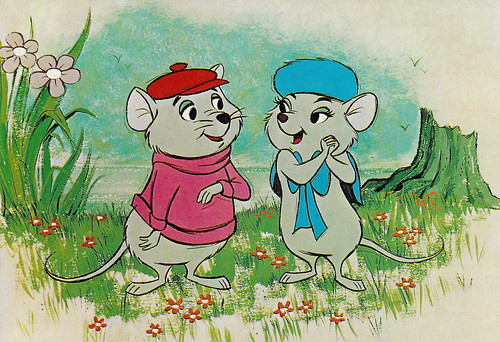
Italian postcard by Grafiche Biondetti, Verona, no. 122 / 4266. Illustration: Walt Disney Productions. Film image of The Rescuers (John Lounsbery, Wolfgang Reitherman, Art Stevens, 1977).

Italian postcard by Grafiche Biondetti, Verona. Illustration: Walt Disney Productions. Film image of The Rescuers (John Lounsbery, Wolfgang Reitherman, Art Stevens, 1977).

Vintage postcard. Illustration: Walt Disney Productions. Film image of The Rescuers (John Lounsbery, Wolfgang Reitherman, Art Stevens, 1977).

Italian postcard by Grafiche Biondetti srl, Verona, no. 122/3. Illustration: Walt Disney Productions. Film image of The Rescuers (John Lounsbery, Wolfgang Reitherman, Art Stevens, 1977).
The Rescue Aid Society
The Rescuers was something of a gamble for Disney studios at the time as they had been veering away from animation for a decade and had been reliant on live-action films and re-releases for their income. They had come close to totally shutting their animation studios some years earlier. Their few post-Jungle Book (1967) animated feature films like The Aristocats (1970) and Robin Hood (1973) had turned decent but unspectacular profits.
They have also resulted in some criticism for lacking the artistic lavishness & memorability of the classic Disney films of the past. Whilst The Rescuers (1977) also suffered some of the same criticisms, it proved hugely popular at the box office.
The film starts with a young orphan named Penny in an abandoned riverboat in Devil's Bayou, Louisiana. She drops a message in a bottle, containing a plea for help, into the river. This message makes its way to the Rescue Aid Society, a mouse organisation in the basement of the United Nations building dedicated to the rescue and well-being of anyone in need.
The Hungarian representative, Miss Bianca, volunteers to accept the case. She chooses Bernard, a stammering janitor, as her co-agent. Searching for clues at Penny's home at Morningside Orphanage in New York City, the two mice discover that the girl has been kidnapped by the evil pawn shop owner Madame Medusa and her companion Mr. Snoops.
On the back of Orville the albatross, Miss Bianca and Bernard travel to the terrifyingly gloomy Devil's Bayou where they learn the shocking truth: the innocent young girl is being forced down into a dangerous, dark underground pirate's cave where she must find the Devil's Eye, the world's largest diamond and Madame Medusa's greatest obsession. Before returning safely home, Miss Bianca, Bernard, and Penny will have to combat Madame Medusa's two ferocious pet alligators Brutus and Nero with the help of Ellie Mae and Evinrude the dragonfly, as well as survive the raging tides inside the horrible pirate's cave.

French postcard by Editions G. Picard / La Rose, no. WD 4/31. Illustration: Walt Disney Productions. Film image of The Rescuers (John Lounsbery, Wolfgang Reitherman, Art Stevens, 1977).

French postcard by Editions G. Picard / La Rose, no. WD 4/32. Illustration: Walt Disney Productions. Film image of The Rescuers (John Lounsbery, Wolfgang Reitherman, Art Stevens, 1977).

French postcard by Editions G. Picard / La Rose, no. WD 4/34. Illustration: Walt Disney Productions. Film image of The Rescuers (John Lounsbery, Wolfgang Reitherman, Art Stevens, 1977).

French postcard by Editions G. Picard / La Rose, no. WD 4/35. Illustration: Walt Disney Productions. Film image of The Rescuers (John Lounsbery, Wolfgang Reitherman, Art Stevens, 1977).
Disney's 'Nine Old Men'
The Rescuers is considered by its producers, critics and audiences to be the film that proved that Walt Disney Productions' animation department would survive following the death of Walt Disney. It was the company's first major critical and financial success since Jungle Book (1967), and its last until The Little Mermaid (1989).
The film was one of the last Walt Disney classics to be animated by members of Walt Disney's 'Nine Old Men'. Veteran animator Milt Kahl stated that he enjoyed his work on the film's villain, Madame Medusa, more than that of any of his other assignments. The character's wacky, explosive nature unleashed his ability to create over-the-top, yet believable, expression and movement that the more confined personalities of previous characters prohibited. Kahl took inspiration from his ex-wife, whom he didn't particularly care for, as well as live-action characters from other films, to bring the wicked character to life.
Don Bluth became the first of the new artists trained during the 1970s to be listed as a directing animator. While working on the film, Bluth noted that some of the characters did not have the whites of their eyes coloured in. When he questioned the reason why, he was told that it was too expensive. Bluth and fellow animator Gary Goldman got their own equipment to test if it was true, they found that it was not too expensive. When they reported back with their discovery, the two were told to follow orders and do as they were told. Bluth referred to this as "the straw that broke the camel's back" which would eventually lead to Bluth and Goldman leaving Disney.
The film's final budget was estimated to be $7.5 million, an astronomical amount at the time. Despite its high budget, the film proved a huge success, managing to out-gross strong competition, such as Star Wars: Episode IV: A New Hope (George Lucas, 1977), in several European countries, including France and West Germany. During its initial release in 1977, the film's distributor rentals amounted to 19 million dollars in the United States and Canada, while its international rentals totalled 41 million dollars.
Following two theatrical re-releases in the 1980s, the film's total lifetime worldwide gross is 169 million dollars. According to their publisher, The Rescuers (1977) helped put all nine of British author Margery Sharp's 'The Rescuers' novels on the bestseller lists; not just 'The Rescuers' (1959) and 'Miss Bianca' (1962), on which the film is based. The film's popularity almost led to a spin-off TV series in 1989. When the animation department green-lit The Rescuers Down Under (Hendel Butoy, Mike Gabriel, 1990), the spin-off was reworked into Chip 'n Dale: Rescue Rangers (1989), with Chip and Dale replacing Bernard and Miss Bianca.
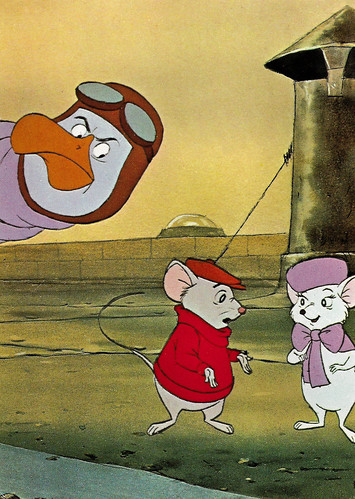
Belgian postcard by Editions Corna, Brussels. Illustration: Walt Disney Productions. Film image of The Rescuers (John Lounsbery, Wolfgang Reitherman, Art Stevens, 1977).
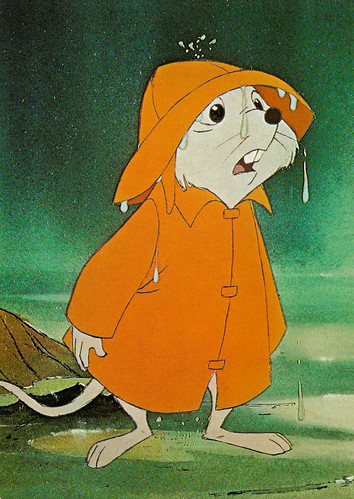
Belgian postcard by Editions Corna, Brussels, sent by mail in 1978. Illustration: Walt Disney Productions. Film image of The Rescuers (John Lounsbery, Wolfgang Reitherman, Art Stevens, 1977).
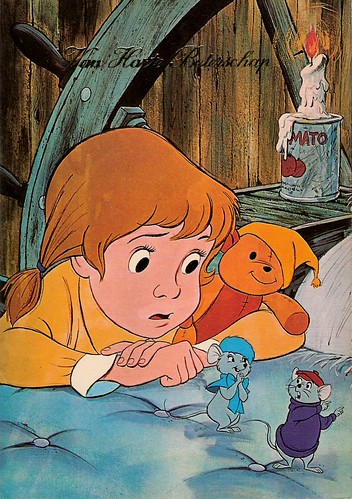
Italian postcard by Grafiche Biondetti, Verona, no. 122, distributed in the Netherlands. Illustration: Walt Disney Productions. Film image of The Rescuers (John Lounsbery, Wolfgang Reitherman, Art Stevens, 1977). Dutch caption: Van Harte Beterschap (Get well soon).
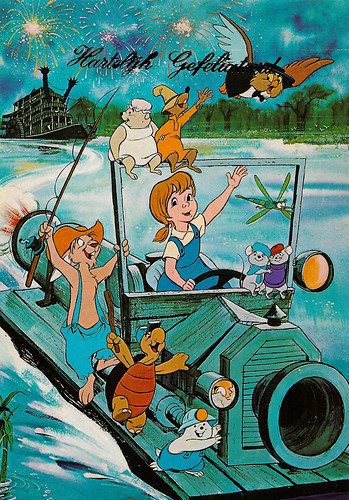
Italian postcard by Grafiche Biondetti, Verona, no. 122, with Dutch text 'Hartelijk gefeliciteerd' (Congratulations). Illustration: Walt Disney Productions. Film image of The Rescuers (John Lounsbery, Wolfgang Reitherman, Art Stevens, 1977).
Sources: Wikipedia and IMDb.
No comments:
Post a Comment